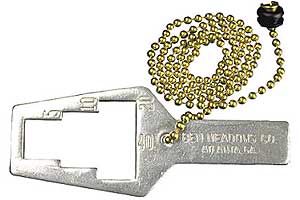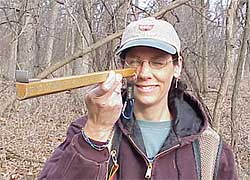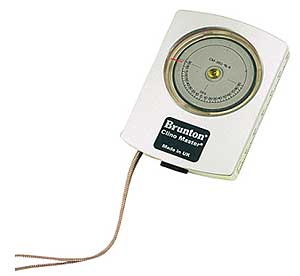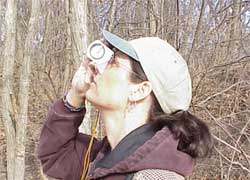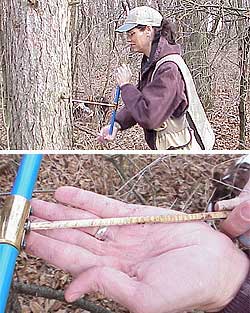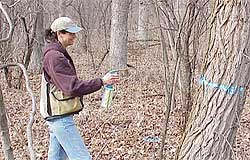
What is this angle gauge used for?
Sorry, try again.
Sorry, try again.
Correct! This tool is called an “angle gauge” and is used to measure stand density. (The number of trees in an area.) The black knob at the end of the chain is held in the forester’s teeth, and the chain is stretched out horizontally. The silver gauge is held out in front of the forester at eye level. Standing in one spot, the forester turns slowly on a circle, looking at the surrounding trees through the gauge. Any tree with a trunk appearing as wide or wider that the opening in the gauge gets counted. The number of trees counted when the forester is done turning one complete circle is multiplied by either 5, 10 or 20, depending on which width opening you were using on the angle gauge. The resulting number is a measurement called “basal area.” If this number is too high, it might be time to thin out some trees so the remaining trees have more room to grow.
In this photo, Mary Ann is using another type of angle gauge, this one mounted on the end of a stick. Every tree with a trunk appearing as wide or wider than the angle gauge gets counted. This cruising stick is also used for measuring tree diameters.
Sorry, try again.
What is this clinometer used for?
Correct! The clinometer is used to measure how tall a tree is. The round dial in the center of the clinometer floats, similar to the arrow on a compass. The forester stands a known distance from the tree to be measured. There is a peep hole on one end of the clinometer, where you can read the numbers on the floating scale.
The forester points the clinometer at the top of the tree, then reads the number on the scale. This number is added to the number read when aiming at the base of the tree to determine the total height of the tree. This tool uses the math concepts involving right triangles that you learn about in trigonometry. (So, study your math!) Foresters can tell how well a tree is growing if they can measure the tree’s height compared to its age. They also use the height measurement to figure out how many logs (and later, boards) they will get when the tree is cut down.
Sorry, try again.
Sorry, try again.
Sorry, try again.
What is this increment borer used for?
Sorry, try again.
Correct! Have you ever looked at a tree stump and counted the growth rings to tell how old the tree was? Foresters use this tool to estimate a tree’s age without having to cut it down. The hollow drill bit is twisted into the trunk of the tree until it’s halfway through. Then the extractor is pushed into the hollow tube. One twist of the borer cuts out a sample core of wood from the tree. The core comes out with the extractor.
The forester counts the growth rings along the edge of the sample core to estimate the tree’s age. We can also tell how fast or slow a tree is growing by how close or far apart the growth rings are. This process does cause a small injury to the tree, which heals quickly. Here you can see Mary Ann drilling the increment borer into a red pine. Next the wood core is removed using the extractor. Can you see the darker growth rings along the edge of the sample core?
Sorry, try again.
Sorry, try again.
What is this paint gun used for?
Sorry, try again.
Sorry, try again.
Sorry, try again.
Foresters understand that a forest needs to be managed in order to stay healthy and productive. You wouldn’t let weeds take over your vegetable garden, so why would we let undesirable trees crowd out the oaks and walnuts? This paint gun (the blue part with the trigger) screws onto a quart sized can of tree marking paint.
The forester squeezes the trigger to squirt out paint. A forester might mark the trees that need to be cut, or they might mark the trees not to be cut. They also use certain colors of paint to mark property lines or timber sale boundaries. In this photo, Mary Ann has marked an undesirable black locust tree to be removed from an oak forest.
So, how did you do on the quiz? Do you see being a forester in your future?

